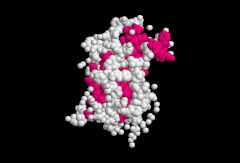Growth hormone
Biological Aspects of Growth Hormone: – Nomenclature includes terms like somatotropin, STH, and somatotropic hormone. – Genes for human growth hormone are located on chromosome […]
Biological Aspects of Growth Hormone:
– Nomenclature includes terms like somatotropin, STH, and somatotropic hormone.
– Genes for human growth hormone are located on chromosome 17.
– Human growth hormone is a 191 amino acid protein.
– GH secretion is regulated by the hypothalamus and affected by various physiological factors.
– GH functions by interacting with specific cell surface receptors and stimulating various processes like height increase and IGF-1 production.
Clinical Significance of Growth Hormone:
– Excess GH can lead to conditions like acromegaly, while deficiency can cause growth failure in children.
– Diagnosis of GH-related disorders involves stimulation tests and identification of underlying causes like pituitary adenomas.
– GH replacement therapy is used in adults with deficiency and for treating conditions like Turner syndrome.
– Psychological effects of GH deficiency can impact quality of life and cognitive function.
Medical Uses and Side Effects of Growth Hormone:
– GH replacement therapy is beneficial for adults with deficiency and in conditions requiring muscle mass maintenance.
– Side effects of GH therapy include injection site reactions, joint pain, carpal tunnel syndrome, and potential immune responses.
– GH misuse for anti-aging or athletic enhancement is associated with health risks and banned in sports.
Regulation and Agricultural Use of Growth Hormone:
– GH secretion is regulated by the hypothalamus-pituitary axis and influenced by factors like sleep, exercise, and stress.
– GH use in livestock is controversial, with bovine somatotropin approved for increasing milk production in dairy cows.
– GH is legally used in raising cows for beef production, while its use in poultry farming is illegal in the US.
Drug Development History and Related Topics:
– Recombinant DNA technology revolutionized GH therapy, replacing cadaver-derived HGH in 1985.
– Various recombinant growth hormones are available for medical use, with FDA approvals for different products.
– Related topics include acromegaly, somatopause, and the history of GH development, including biosynthetic and recombinant forms.
Growth hormone (GH) or somatotropin, also known as human growth hormone (hGH or HGH) in its human form, is a peptide hormone that stimulates growth, cell reproduction, and cell regeneration in humans and other animals. It is thus important in human development. GH also stimulates production of Insulin-like growth factor 1 (IGF-1) and increases the concentration of glucose and free fatty acids. It is a type of mitogen which is specific only to the receptors on certain types of cells. GH is a 191-amino acid, single-chain polypeptide that is synthesized, stored and secreted by somatotropic cells within the lateral wings of the anterior pituitary gland.
| Growth hormone 1 (pituitary) | |||||||
|---|---|---|---|---|---|---|---|
 Growth hormone | |||||||
| Identifiers | |||||||
| Symbol | GH1 | ||||||
| NCBI gene | 2688 | ||||||
| HGNC | 4261 | ||||||
| OMIM | 139250 | ||||||
| RefSeq | NM_022562 | ||||||
| UniProt | P01241 | ||||||
| Other data | |||||||
| Locus | Chr. 17 q22-q24 | ||||||
| |||||||
| Growth hormone 2 (placental) | |||||||
|---|---|---|---|---|---|---|---|
| Identifiers | |||||||
| Symbol | GH2 | ||||||
| NCBI gene | 2689 | ||||||
| HGNC | 4262 | ||||||
| OMIM | 139240 | ||||||
| RefSeq | NM_002059 | ||||||
| UniProt | P01242 | ||||||
| Other data | |||||||
| Locus | Chr. 17 q22-q24 | ||||||
| |||||||
A recombinant form of HGH called somatropin (INN) is used as a prescription drug to treat children's growth disorders and adult growth hormone deficiency. In the United States, it is only available legally from pharmacies by prescription from a licensed health care provider. In recent years in the United States, some health care providers are prescribing growth hormone in the elderly to increase vitality. While legal, the efficacy and safety of this use for HGH has not been tested in a clinical trial. Many of the functions of HGH remain unknown.
In its role as an anabolic agent, HGH has been used by competitors in sports since at least 1982, and has been banned by the IOC and NCAA. Traditional urine analysis does not detect doping with HGH, so the ban was not enforced until the early 2000s, when blood tests that could distinguish between natural and artificial HGH were starting to be developed. Blood tests conducted by WADA at the 2004 Olympic Games in Athens, Greece, targeted primarily HGH. Use of the drug for performance enhancement is not currently approved by the FDA.
GH has been studied for use in raising livestock more efficiently in industrial agriculture and several efforts have been made to obtain governmental approval to use GH in livestock production. These uses have been controversial. In the United States, the only FDA-approved use of GH for livestock is the use of a cow-specific form of GH called bovine somatotropin for increasing milk production in dairy cows. Retailers are permitted to label containers of milk as produced with or without bovine somatotropin.